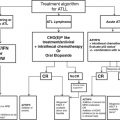Fig. 1
Histological stages. (a) Type I: endometrioid adenocarcinoma. (b) Type II: serous papillary adenocarcinoma
Type I is endometrioid adenocarcinoma.
Type II is high-grade tumors which include clear cell, serous papillary, and carcinosarcoma.
Type I cancer affects older menopausal women who have diabetes, hypertension, and overweight [8–10]. The mechanism behind this type of cancer is hyperestrogenism [8].
Type II cancer affects younger women without overweight. This cancer type has worse prognosis [11].
Type I cancer represents 80–90 % of endometrial cancers in developed countries [12] and only 75–80 % in developing countries [13, 14]. Patients in developing countries are younger than in developed countries [3, 13, 15]; overall incidence of this cancer is increasing. It is due to the aging population and lifestyle changes (obesity, diabetes, hypertension) leading to an increased incidence of type I [6, 16]. Five-year survival is 85 and 30 % in type I and type II endometrial cancers, respectively [11, 12].
3 Presentation and Initial Diagnostic Procedure
The diagnosis is suspected on genital bleeding in 78–90 % of cases [3, 12]. Diagnosis is made at a later stage [17]; in developing countries [3], prognosis is thus worse [2].
Ideally the initial diagnostic procedure combines a biopsy though the Cormier picker or hysteroscopy curettage to allow diagnosis of histological type and grade. Pelvic MRI, thoracoabdominal and pelvic CT scan, or a PET scanner is mandatory to determine the stage. Once the type, grade, and stage have been determined, the treatment can be proposed and adapted according to the FIGO classification [18].
Despite a full pretherapeutic assessment, it is observed that an undervaluation of grade and/or histological type is 20–38 % of cases [19]. Myometrial infiltration on MRI is undervalued in 35 % and over evaluated in 10 % of cases, respectively [20].
PET scan is more accurate for the preoperative diagnosis of lymph node involvement. The sensitivity is 53.3 %, specificity 99.6 %, and accuracy 97, 8 % [21]. Standard imaging techniques (CT or MRI) are based only on morphological information. To be relevant, abnormalities must be greater than 10 mm; with PET scan, there is a gain of sensitivity since the detection of lymph node metastases is 93.3 % for lymph nodes of more than 10 mm, 66.7 % for those of 5–9 mm, and 16.7 % for those of less than 5 mm [22].
Despite that, PET scan is not essential to patients care of and can be replaced by the association thoracoabdominal-pelvis CT scan and pelvic MRI. This reveals the difficulties in obtaining a reliable pretherapeutic diagnosis. But it is important to have this evaluation to be able to differentiate advanced from local stages.
4 Staging
The Fédération Internationale de Gynécologie et d’Obstétrique (FIGO) has actualized endometrial cancer staging in May 2009 [18] (Table 1).
Table 1
2009 FIGO staging system for carcinoma of endometrium
Stage Ia | Tumor contained to the corpus uteri | ||
|---|---|---|---|
IA | No or less than half myometrial invasion | ||
IB | Invasion equal to or more than half of the myometrium | ||
Stage II | Tumor invades the cervical stroma, but does not extend beyond the uterusb | ||
Stage IIIa | Local and/or regional spread of tumorc | ||
IIIA | Tumor invades the serosa of the corpus uteri and/or adnexas | ||
IIIB | Vaginal and/or parametrial involvement | ||
IIIC | Metastases to pelvis and/or para-aortic lymph nodes | ||
IIIC1 | Positive pelvic nodes | ||
IIIC2 | Positive para-aortic lymph nodes with or without positive pelvic lymph nodes | ||
Stage IVa | Tumor invades bladder and/or bowel mucosa and/or distant metastases | ||
IVA | Tumor invasion of bladder and/or bowel mucosa | ||
IVB | Distant metastases, including intra-abdominal metastases and or inguinal lymph nodes | ||
When comparing the 2009 to the 1988 classification, the following changes have been made: former stages IA and IB have been merged. The stage IIA was eliminated. The positive peritoneal cytology no longer upstages the disease because it is not an independent prognostic factor. Finally, stage IIIC was differentiated in stage IIIC1 and IIIC2 depending of pelvic or lomboaortic nodes involvement.
The European Society of Medical Oncology (ESMO) also proposed a histoprognostic classification which was revised in 2008 [23] (Table 2).
Table 2
Classification of early stages endometrioid adenocarcinoma
Grade 1 | Grade 2 | Grade 3 | |
|---|---|---|---|
IA | Low | Low | Intermediate |
IB | Intermediate | Intermediate | High |
These changes require an adaptation of the surgical management. Type I stage IA grade 1 and 2 (low-risk) patients do not require lymph node dissection. The benefit of the node staging is lower than the risk of complications. The risk of harm is less than 5 % [19] even 0 % if tumor size is less than 2 cm [24].
In other cases the complete lymph node dissection (pelvic and para-aortic) is the standard for high-risk patients, and this can be discussed in intermediate risks. The justification of extended lymphadenectomy is explained by the distribution of lymph node metastases: 33 % isolated pelvic, 16 % isolated lomboaortic, and 51 % combined lymph node involvement [25]. The lomboaortic dissection should be conducted to the renal vein because 60 % of supramesenteric-affected lymph node patients have no inframesenteric lomboaortic lymph node involvement [25].
In case of high-risk lesion with poor prognostic factors (type II), it is mandatory to perform peritoneal staging: omentectomy, peritoneal biopsies, and appendectomy.
5 Treatment
5.1 Surgical Management
International recommendations are weighted to the population profile of their specific features, medico-economic conditions, and opportunities of developing countries [26]. Surgery is the cornerstone of endometrial cancer treatment. The procedure should be immediately extended and adapted to clinical assessment if the disease is of high grade or of type II. This will avoid further surgery and therefore significant morbidity. The heterogeneity of surgical skill does not provide adequate treatment in all structures. Depending on the country, the surgical treatment is not suitable in 41–79 % of cases [3, 13, 27]. Inadequate surgical procedure does not set a reliable stage and leads to inappropriate adjuvant treatment in 20–40 % of cases [28].
The recurrence risk may therefore be as high as 68 % in these under staged patients [13, 27]. Five-year disease-free survival in types I and II stage I patients falls from 95 to 70 % in case of incomplete surgery [13].
It is important to remember that the nodal staging is mandatory because it is a prognostic factor; however, it is not therapeutic [6]. This is in favor of the management in two stages as proposed by some authors. A first single management for reliable diagnosis and then addressing the patient to a referral center are needed for further management [6]. This procedure allows patients to have access to a technical platform and surgical skills appropriate to their characteristics [6].
The lack of lymph node dissection in low-risk patients is still debated. Current recommendations in developed countries are consistent with therapeutic down-escalation. Some authors question this strategy because they suspect a decrease in disease-free survival in low-grade patients if the lymph node dissection was not performed [13]. Lymph node staging may have even a survival benefit for the three groups’ stages in type I cancer [27]. This remains to be confirmed in powered prospective studies. The lack of lymph node dissection in low-risk patients in developing countries appears to be a futile concern at the sight of the difficulties encountered in the application of surgical standards due to the lack of adequately trained surgical resources [6].
Stay updated, free articles. Join our Telegram channel

Full access? Get Clinical Tree





